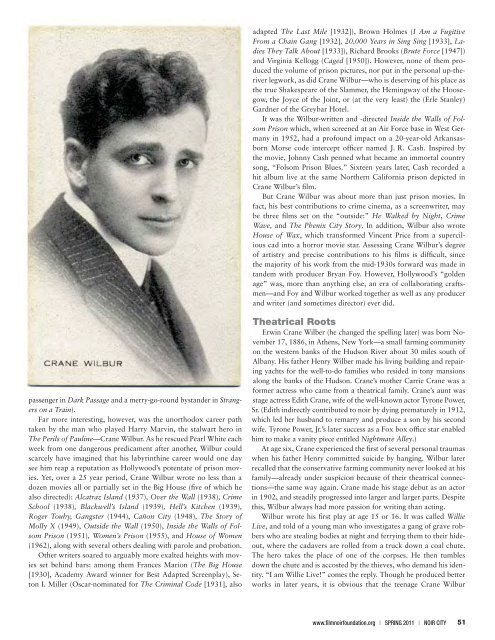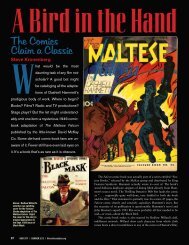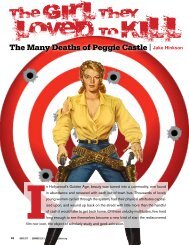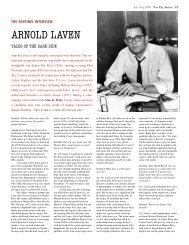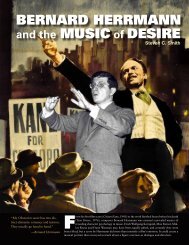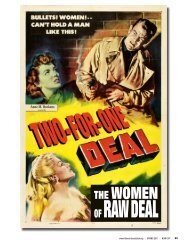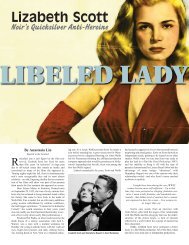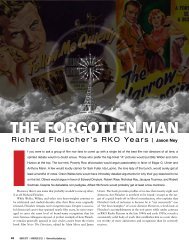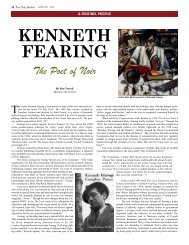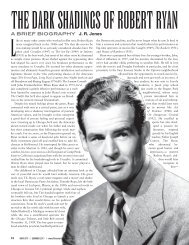Crane Wilbur - Film Noir Foundation
Crane Wilbur - Film Noir Foundation
Crane Wilbur - Film Noir Foundation
Create successful ePaper yourself
Turn your PDF publications into a flip-book with our unique Google optimized e-Paper software.
passenger in Dark Passage and a merry-go-round bystander in Strangers<br />
on a Train).<br />
Far more interesting, however, was the unorthodox career path<br />
taken by the man who played Harry Marvin, the stalwart hero in<br />
The Perils of Pauline—<strong>Crane</strong> <strong>Wilbur</strong>. As he rescued Pearl White each<br />
week from one dangerous predicament after another, <strong>Wilbur</strong> could<br />
scarcely have imagined that his labyrinthine career would one day<br />
see him reap a reputation as Hollywood’s potentate of prison movies.<br />
Yet, over a 25 year period, <strong>Crane</strong> <strong>Wilbur</strong> wrote no less than a<br />
dozen movies all or partially set in the Big House (five of which he<br />
also directed): Alcatraz Island (1937), Over the Wall (1938), Crime<br />
School (1938), Blackwell’s Island (1939), Hell’s Kitchen (1939),<br />
Roger Touhy, Gangster (1944), Cañon City (1948), The Story of<br />
Molly X (1949), Outside the Wall (1950), Inside the Walls of Folsom<br />
Prison (1951), Women’s Prison (1955), and House of Women<br />
(1962), along with several others dealing with parole and probation.<br />
Other writers soared to arguably more exalted heights with movies<br />
set behind bars: among them Frances Marion (The Big House<br />
[1930], Academy Award winner for Best Adapted Screenplay), Seton<br />
I. Miller (Oscar-nominated for The Criminal Code [1931], also<br />
adapted The Last Mile [1932]), Brown Holmes (I Am a Fugitive<br />
From a Chain Gang [1932], 20,000 Years in Sing Sing [1933], Ladies<br />
They Talk About [1933]), Richard Brooks (Brute Force [1947])<br />
and Virginia Kellogg (Caged [1950]). However, none of them produced<br />
the volume of prison pictures, nor put in the personal up-theriver<br />
legwork, as did <strong>Crane</strong> <strong>Wilbur</strong>—who is deserving of his place as<br />
the true Shakespeare of the Slammer, the Hemingway of the Hoosegow,<br />
the Joyce of the Joint, or (at the very least) the (Erle Stanley)<br />
Gardner of the Greybar Hotel.<br />
It was the <strong>Wilbur</strong>-written and -directed Inside the Walls of Folsom<br />
Prison which, when screened at an Air Force base in West Germany<br />
in 1952, had a profound impact on a 20-year-old Arkansasborn<br />
Morse code intercept officer named J. R. Cash. Inspired by<br />
the movie, Johnny Cash penned what became an immortal country<br />
song, “Folsom Prison Blues.” Sixteen years later, Cash recorded a<br />
hit album live at the same Northern California prison depicted in<br />
<strong>Crane</strong> <strong>Wilbur</strong>’s film.<br />
But <strong>Crane</strong> <strong>Wilbur</strong> was about more than just prison movies. In<br />
fact, his best contributions to crime cinema, as a screenwriter, may<br />
be three films set on the “outside:” He Walked by Night, Crime<br />
Wave, and The Phenix City Story. In addition, <strong>Wilbur</strong> also wrote<br />
House of Wax, which transformed Vincent Price from a supercilious<br />
cad into a horror movie star. Assessing <strong>Crane</strong> <strong>Wilbur</strong>’s degree<br />
of artistry and precise contributions to his films is difficult, since<br />
the majority of his work from the mid-1930s forward was made in<br />
tandem with producer Bryan Foy. However, Hollywood’s “golden<br />
age” was, more than anything else, an era of collaborating craftsmen—and<br />
Foy and <strong>Wilbur</strong> worked together as well as any producer<br />
and writer (and sometimes director) ever did.<br />
Theatrical Roots<br />
Erwin <strong>Crane</strong> Wilber (he changed the spelling later) was born November<br />
17, 1886, in Athens, New York—a small farming community<br />
on the western banks of the Hudson River about 30 miles south of<br />
Albany. His father Henry Wilber made his living building and repairing<br />
yachts for the well-to-do families who resided in tony mansions<br />
along the banks of the Hudson. <strong>Crane</strong>’s mother Carrie <strong>Crane</strong> was a<br />
former actress who came from a theatrical family. <strong>Crane</strong>’s aunt was<br />
stage actress Edith <strong>Crane</strong>, wife of the well-known actor Tyrone Power,<br />
Sr. (Edith indirectly contributed to noir by dying prematurely in 1912,<br />
which led her husband to remarry and produce a son by his second<br />
wife. Tyrone Power, Jr.’s later success as a Fox box office star enabled<br />
him to make a vanity piece entitled Nightmare Alley.)<br />
At age six, <strong>Crane</strong> experienced the first of several personal traumas<br />
when his father Henry committed suicide by hanging. <strong>Wilbur</strong> later<br />
recalled that the conservative farming community never looked at his<br />
family—already under suspicion because of their theatrical connections—the<br />
same way again. <strong>Crane</strong> made his stage debut as an actor<br />
in 1902, and steadily progressed into larger and larger parts. Despite<br />
this, <strong>Wilbur</strong> always had more passion for writing than acting.<br />
<strong>Wilbur</strong> wrote his first play at age 15 or 16. It was called Willie<br />
Live, and told of a young man who investigates a gang of grave robbers<br />
who are stealing bodies at night and ferrying them to their hideout,<br />
where the cadavers are rolled from a truck down a coal chute.<br />
The hero takes the place of one of the corpses. He then tumbles<br />
down the chute and is accosted by the thieves, who demand his identity.<br />
“I am Willie Live!” comes the reply. Though he produced better<br />
works in later years, it is obvious that the teenage <strong>Crane</strong> <strong>Wilbur</strong><br />
www.filmnoirfoundation.org i SPrinG 2011 i noir citY 51


